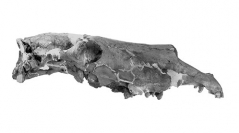

 Geodiversitas
26 (3) - Pages 535-561
Geodiversitas
26 (3) - Pages 535-561Evidence is given for the presence of at least three species of Equus at Nalaikha, Mongolia. The smallest, E. nalaikhaensis Kuznetsova & Zhegallo, 1996, well represented by skull and limb bones, belongs certainly to modern Equus (not Allohippus Gromova, 1949) and exhibits a mosaic of characters found in extant hemiones, asses, and Grevy’s zebras and in fossil E. altidens v. Reichenau, 1915 (from Süssenborn) and E. hipparionoides Vekua, 1962 (from Akhalkalaki). In accordance with recent biomolecular studies of equids, E. nalaikhaensis may be placed after the individualisation of caballines and between the branching points of hemiones and of the ass-zebra lineage. The other species of Nalaikha are not well represented. They may be related to northeastern Siberian fossils of Olyorian age, in particular to caballines and to E. suessenbornensis Wüst, 1901 s.l. Other true Equus (in particular E. scotti Gidley, 1900, E. coliemensis Lazarev, 1980, E. apolloniensis Koufos, Kostopoulos & Sylvestrou 1997, and E. graziosii Azzaroli, 1966) are also documented and discussed, stressing the frequent dissociation of characters usually associated in extant species.
Mammalia, Perissodactyla, Equus, early Pleistocene, Mongolia, Old World, North America, craniology, phylogeny